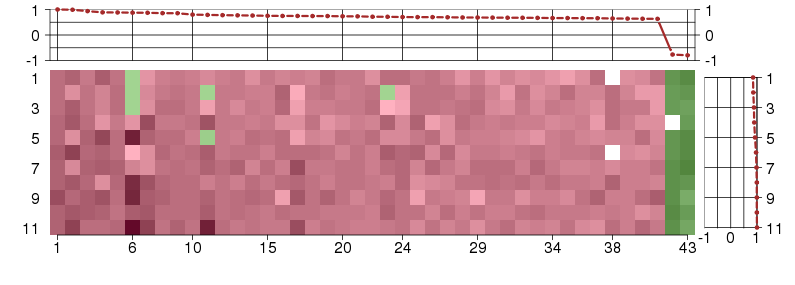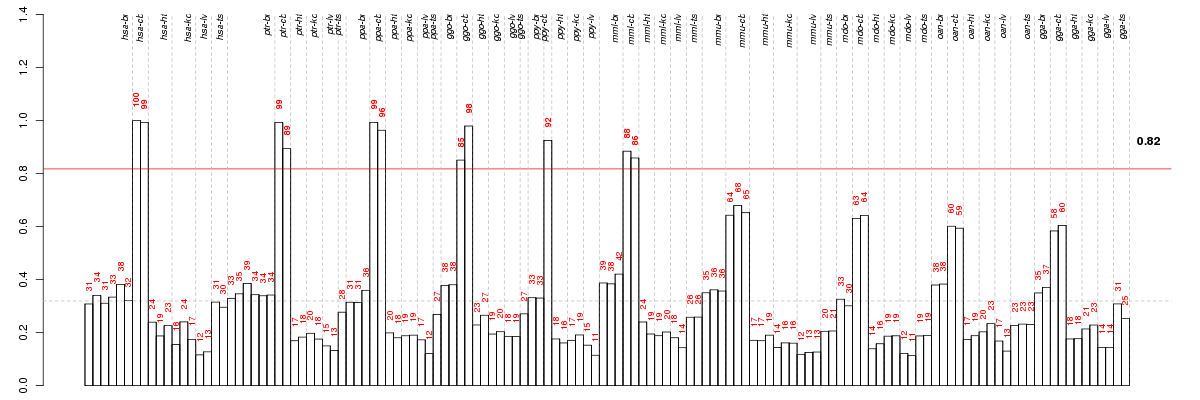



Under-expression is coded with green,
over-expression with red color.

multicellular organismal development
The biological process whose specific outcome is the progression of a multicellular organism over time from an initial condition (e.g. a zygote or a young adult) to a later condition (e.g. a multicellular animal or an aged adult).
nervous system development
The process whose specific outcome is the progression of nervous tissue over time, from its formation to its mature state.
biological_process
Any process specifically pertinent to the functioning of integrated living units: cells, tissues, organs, and organisms. A process is a collection of molecular events with a defined beginning and end.
cellular process
Any process that is carried out at the cellular level, but not necessarily restricted to a single cell. For example, cell communication occurs among more than one cell, but occurs at the cellular level.
neurogenesis
Generation of cells within the nervous system.
cell differentiation
The process whereby relatively unspecialized cells, e.g. embryonic or regenerative cells, acquire specialized structural and/or functional features that characterize the cells, tissues, or organs of the mature organism or some other relatively stable phase of the organism's life history. Differentiation includes the processes involved in commitment of a cell to a specific fate and its subsequent development to the mature state.
multicellular organismal process
Any biological process, occurring at the level of a multicellular organism, pertinent to its function.
developmental process
A biological process whose specific outcome is the progression of an integrated living unit: an anatomical structure (which may be a subcellular structure, cell, tissue, or organ), or organism over time from an initial condition to a later condition.
system development
The process whose specific outcome is the progression of an organismal system over time, from its formation to the mature structure. A system is a regularly interacting or interdependent group of organs or tissues that work together to carry out a given biological process.
anatomical structure development
The biological process whose specific outcome is the progression of an anatomical structure from an initial condition to its mature state. This process begins with the formation of the structure and ends with the mature structure, whatever form that may be including its natural destruction. An anatomical structure is any biological entity that occupies space and is distinguished from its surroundings. Anatomical structures can be macroscopic such as a carpel, or microscopic such as an acrosome.
cellular developmental process
A biological process whose specific outcome is the progression of a cell over time from an initial condition to a later condition.
all
NA
multicellular organismal development
The biological process whose specific outcome is the progression of a multicellular organism over time from an initial condition (e.g. a zygote or a young adult) to a later condition (e.g. a multicellular animal or an aged adult).
cellular developmental process
A biological process whose specific outcome is the progression of a cell over time from an initial condition to a later condition.
system development
The process whose specific outcome is the progression of an organismal system over time, from its formation to the mature structure. A system is a regularly interacting or interdependent group of organs or tissues that work together to carry out a given biological process.
neurogenesis
Generation of cells within the nervous system.


molecular_function
Elemental activities, such as catalysis or binding, describing the actions of a gene product at the molecular level. A given gene product may exhibit one or more molecular functions.
signal transducer activity
Mediates the transfer of a signal from the outside to the inside of a cell by means other than the introduction of the signal molecule itself into the cell.
receptor activity
Combining with an extracellular or intracellular messenger to initiate a change in cell activity.
transmembrane receptor activity
Combining with an extracellular or intracellular messenger to initiate a change in cell activity, and spanning to the membrane of either the cell or an organelle.
hedgehog receptor activity
Combining with the hedgehog protein to initiate a change in cell activity.
molecular transducer activity
The molecular function that accepts an input of one form and creates an output of a different form.
all
NA
ANKS6ankyrin repeat and sterile alpha motif domain containing 6 (ENSG00000165138), score: 0.63 C6orf115chromosome 6 open reading frame 115 (ENSG00000146386), score: -0.8 C7orf16chromosome 7 open reading frame 16 (ENSG00000106341), score: 0.65 C8orf79chromosome 8 open reading frame 79 (ENSG00000170941), score: 0.7 CBLN1cerebellin 1 precursor (ENSG00000102924), score: 0.73 CCNJLcyclin J-like (ENSG00000135083), score: 0.7 CDH7cadherin 7, type 2 (ENSG00000081138), score: 0.68 CDONCdon homolog (mouse) (ENSG00000064309), score: 0.66 CHRNA3cholinergic receptor, nicotinic, alpha 3 (ENSG00000080644), score: 0.87 CNOT2CCR4-NOT transcription complex, subunit 2 (ENSG00000111596), score: 0.66 CNTN6contactin 6 (ENSG00000134115), score: 0.75 CRTAMcytotoxic and regulatory T cell molecule (ENSG00000109943), score: 1 ETV6ets variant 6 (ENSG00000139083), score: -0.77 FAT2FAT tumor suppressor homolog 2 (Drosophila) (ENSG00000086570), score: 0.85 FGF5fibroblast growth factor 5 (ENSG00000138675), score: 0.77 FLT3fms-related tyrosine kinase 3 (ENSG00000122025), score: 0.7 FZD7frizzled homolog 7 (Drosophila) (ENSG00000155760), score: 0.67 KCNK10potassium channel, subfamily K, member 10 (ENSG00000100433), score: 0.69 KCNK9potassium channel, subfamily K, member 9 (ENSG00000169427), score: 0.75 KCTD2potassium channel tetramerisation domain containing 2 (ENSG00000180901), score: 0.68 LDLRAP1low density lipoprotein receptor adaptor protein 1 (ENSG00000157978), score: 0.73 LRCH1leucine-rich repeats and calponin homology (CH) domain containing 1 (ENSG00000136141), score: 0.69 MAB21L1mab-21-like 1 (C. elegans) (ENSG00000180660), score: 0.86 MAML3mastermind-like 3 (Drosophila) (ENSG00000196782), score: 0.66 MDGA1MAM domain containing glycosylphosphatidylinositol anchor 1 (ENSG00000112139), score: 0.94 MYT1myelin transcription factor 1 (ENSG00000196132), score: 0.76 NKX6-3NK6 homeobox 3 (ENSG00000165066), score: 0.99 PAX6paired box 6 (ENSG00000007372), score: 0.74 PTCH1patched 1 (ENSG00000185920), score: 0.72 PTCHD1patched domain containing 1 (ENSG00000165186), score: 0.64 SKIv-ski sarcoma viral oncogene homolog (avian) (ENSG00000157933), score: 0.64 SKOR1SKI family transcriptional corepressor 1 (ENSG00000188779), score: 0.69 SLC35F4solute carrier family 35, member F4 (ENSG00000151812), score: 0.74 SPINK6serine peptidase inhibitor, Kazal type 6 (ENSG00000178172), score: 0.88 SPTBN5spectrin, beta, non-erythrocytic 5 (ENSG00000137877), score: 0.89 TFAP2Etranscription factor AP-2 epsilon (activating enhancer binding protein 2 epsilon) (ENSG00000116819), score: 0.71 TIAM1T-cell lymphoma invasion and metastasis 1 (ENSG00000156299), score: 0.8 TLL1tolloid-like 1 (ENSG00000038295), score: 0.66 TP73tumor protein p73 (ENSG00000078900), score: 0.75 TRIM67tripartite motif-containing 67 (ENSG00000119283), score: 0.68 VSX1visual system homeobox 1 (ENSG00000100987), score: 0.79 ZIC4Zic family member 4 (ENSG00000174963), score: 0.88 ZNF521zinc finger protein 521 (ENSG00000198795), score: 0.78
| Id | species | tissue | sex | individual |
|---|---|---|---|---|
| ggo_cb_m_ca1 | ggo | cb | m | _ |
| mml_cb_f_ca1 | mml | cb | f | _ |
| mml_cb_m_ca1 | mml | cb | m | _ |
| ptr_cb_f_ca1 | ptr | cb | f | _ |
| ppy_cb_f_ca1 | ppy | cb | f | _ |
| ppa_cb_f_ca1 | ppa | cb | f | _ |
| ggo_cb_f_ca1 | ggo | cb | f | _ |
| ptr_cb_m_ca1 | ptr | cb | m | _ |
| hsa_cb_f_ca1 | hsa | cb | f | _ |
| ppa_cb_m_ca1 | ppa | cb | m | _ |
| hsa_cb_m_ca1 | hsa | cb | m | _ |
